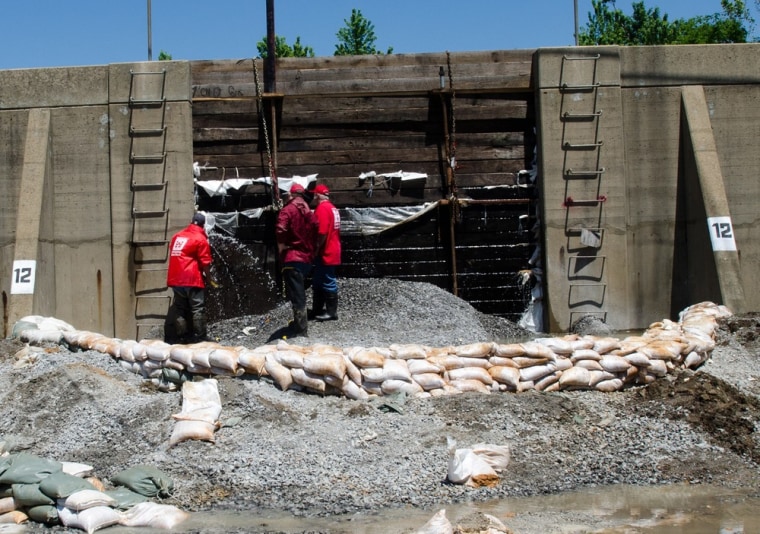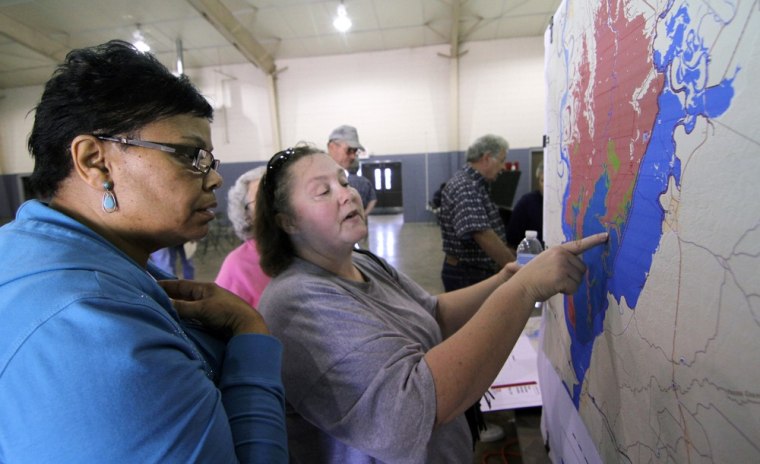As flooding backed up traffic on a major interstate between Tennessee and Arkansas, Memphis worried that some 5,300 homes, schools and businesses could be swamped next week by the Mississippi River.
Flooding along the White River created an 11-mile traffic jam when a stretch of westbound Interstate 40 linking Memphis to Little Rock, Ark., had to be closed Wednesday afternoon. The eastbound lanes were expected to be closed soon as well. The corridor typically sees 31,000 vehicles a day.
Arkansas also recorded its eighth death since the rains started April 25. Authorities found the body of a man in the floodwaters in eastern Arkansas' Prairie County. The man has not yet been identified.
Memphis — where the Mississippi was at 44 feet, two inches, Wednesday morning — could see a near-record crest of 48 feet on May 11, just inches lower than the record of 48.7 feet in 1937. In addition, more than 11 inches of rain that have soaked the Memphis area since April 25.
Water from the Wolf and Loosahatchie rivers already has seeped into parts of the suburbs, and some mobile home parks were swamped.
Flood fears earlier prompted an emergency declaration for 920,000 residents in Shelby County, which includes Memphis. Authorities blocked some suburban streets and about 220 people were staying in shelters.
Flooding already has begun in Dyersburg, which is about 70 miles northeast of Memphis. Mayor John Holden said that people in parts of that city near the North Fork of the Forked Deer River should evacuate.
From Illinois to Mississippi, thousands of people have already been forced from their homes, and anxiety is rising along with the mighty river, even though it could be a week or two before some of the most severe flooding hits.
Across the lower Mississippi and other rivers, the water was expected to crest well above flood stages in a region still dealing with the aftermath of last week's deadly tornadoes.
High water earlier shut down nine river casinos in northwest Mississippi's Tunica County, where about 600 residents have been evacuated from flood-prone areas on the inside of the levee.
In Kentucky, about 3,800 people have been evacuated from three western cities as officials project rivers to crest Friday, and another bout of storms is expected for the region over the weekend.
Most people have sought shelter with family members, though nearly 40 residents were spread out between four shelters.
"I've never seen it this bad," said 78-year-old Joe Harrison, who has lived in the same house in Hickman, Ky., since he was 11 months old.

Floodwaters from the Mississippi turned his house into an island — dry but surrounded by water. He has been using a boat to get to his car, parked on dry ground along a highway that runs by his house.
'Still getting snowmelt'
Up and down the Big Muddy, farmers braced for a repeat of the desperate strategy employed earlier this week in Missouri, where Army engineers blew up a levee and sacrificed vast stretches of farmland to protect populated areas upstream.
Water continues to rise to record levels in the southeast Missouri town of Caruthersville, with water at 46.5 feet, according to John Campbell, operations chief for the Missouri State Emergency Management Agency. The previous record was 46 feet in 1937.
The town is protected by an earthen levee, then a "sea wall" made of concrete. Sandbagging is underway west of this to build a secondary wall. "There is concern there is going to be a record flood there," Campbell said. The community has about 6,700 residents.
The looming disaster is being compared to the great floods of 1927 and 1937.
Tom Salem, a meteorologist with the National Weather Service, said flooding is extreme this year because the Ohio River and the Tennessee River valleys have been drenched with rain in the past two weeks.
Tributaries that flow into the Mississippi are backing up, too, because the river itself is so high. And they account for some of the worst of the flooding so far.
"It's been a massive amount of rain for a long period of time. And we're still getting snowmelt from Montana," Salem said.
In some areas, Wednesday was the first day without rain since April 25.
The great flood of the lower Mississippi River valley in 1927 was one of the worst natural disasters in U.S. history. More than 23,000 square miles were inundated, hundreds of thousands of people were displaced and about 250 died.
In the aftermath, authorities were criticized for helping rescue whites while leaving thousands of black plantation workers stranded for days without food or drinking water. The flood found its place in folklore, literature and films, and popular songs including "When the Levee Breaks" were written about the disaster.
Another flood in 1937 was also devastating, submerging 31,000 square miles from West Virginia to Louisiana.
Lifelong Hickman resident H.L. Williamson, 77, was a boy when he and his family fled to the highest point in town. He recalled little of the experience except that his brother wouldn't eat black-eyed peas or grapefruit for years because that was all they had during the flood.
This time, Williamson packed up and left his home, which was still dry thanks to a hill just inches higher than the floodwaters. He took only a few belongings, including the Navy uniform he hopes to be buried in.
The U.S. Army Corps of Engineers' demolition of a Missouri levee on Monday eased flood worries for some communities. In Cairo, Ill., a town of about 2,800 people at the confluence of the Ohio and Mississippi rivers, the Ohio dropped a foot and a half.
But the relief downstream in Kentucky, Arkansas, Tennessee, Mississippi and Louisiana — is probably only temporary because the water will eventually find its way back into the Mississippi.
Hickman, a town of about 2,500, has floodwalls and the river isn't expected to top them. But officials are concerned about the earthen levee that adjoins the wall. It has been reinforced with about 100,000 sandbags.
Also, contractor was running 90 dump trucks 24 hours a day between a quarry and the levee in Hickman, bringing in rock to fortify the town's flood defenses.
In Louisiana, shippers, ports and the chemical industry are hoping the government can dredge fast enough to keep a major channel into the Gulf of Mexico unclogged. The Mississippi sends huge amounts of sediment downriver during high-water times.
After Memphis, the Mississippi is expected to crest May 12 at Helena, Ark., and farther south in the following days. Forecasters predict record levels at the towns of Vicksburg and Natchez, Miss.
Mississippi officials told about 1,000 people packed at a National Guard armory Wednesday that they're confident the main levees along the Mississippi River will withstand high water levels expected in the coming weeks, but they warn Yazoo backwater levees could be overtopped by as much as a foot.
Peter Nimrod, chief engineer with the Mississippi Levee Board, said people in low areas should secure their property and prepare to leave.

Sherry Hern was at the meeting, trying to find out if she should flee her house on the banks of the Sunflower River near west-central Mississippi.
"Am I scared? Yeah, I am," said Hern, 50.
Hern said the officials used too much technical language, and the unpredictability of the situation left some like Hern wanting a better explanation.
"We're stressed out because we don't know if we're going to get it and they still can't tell me," she said.
Mississippi Gov. Haley Barbour warned people to expect "monumental" flooding and said he was moving his furniture from his family's lakeside home to prepare for flooding from the Yazoo River.